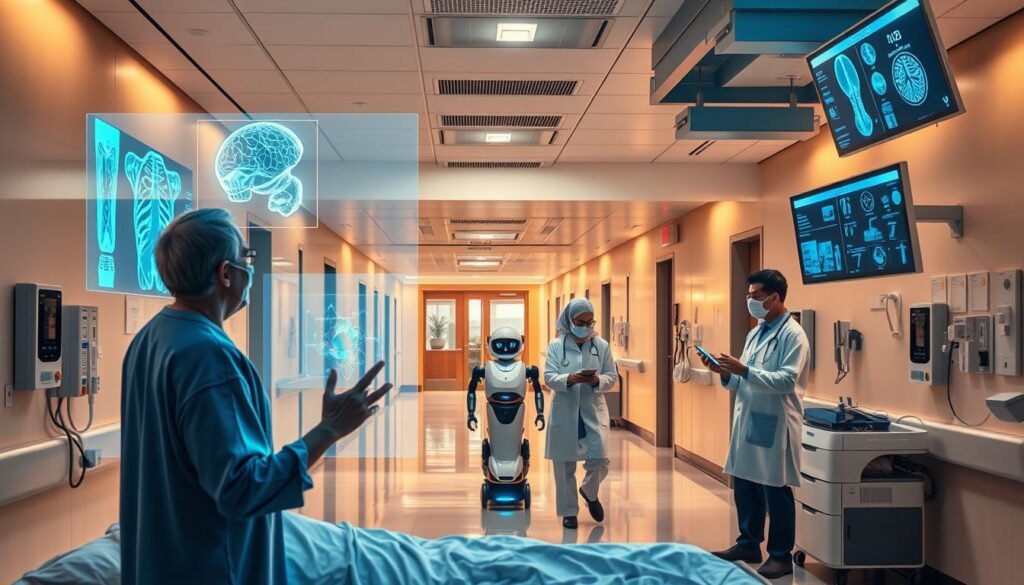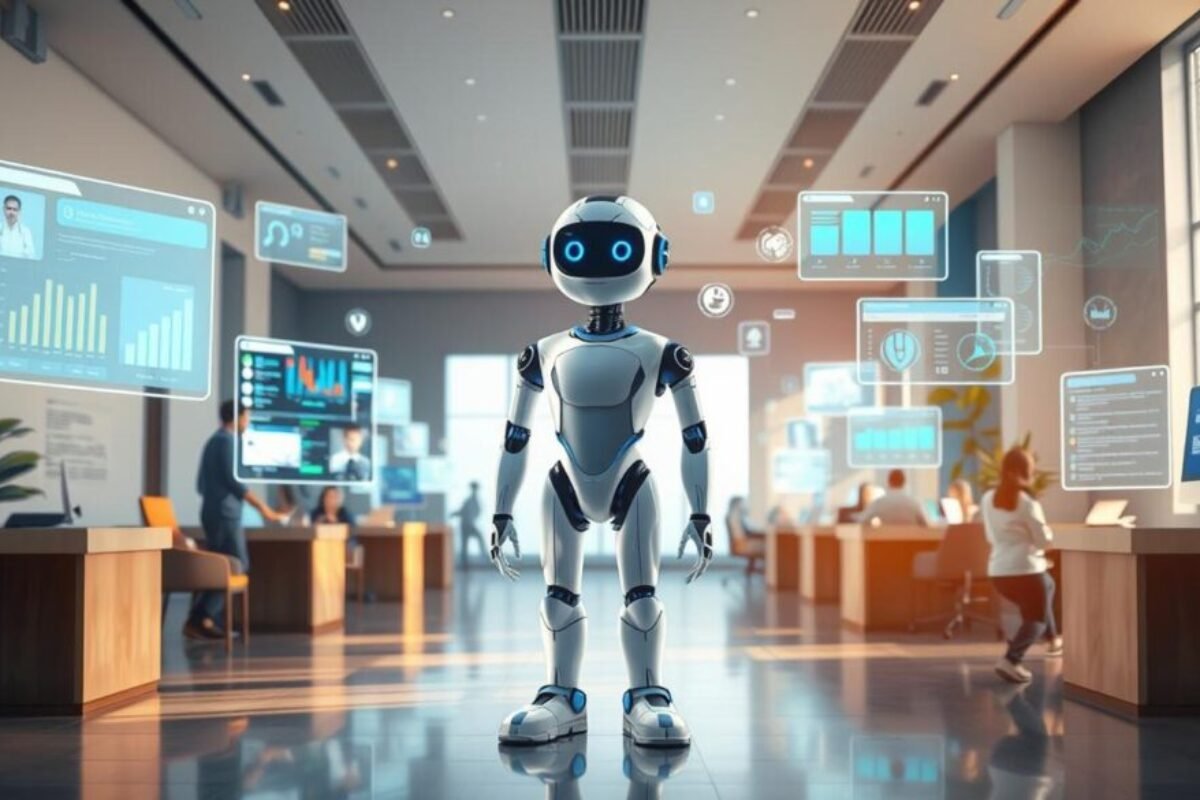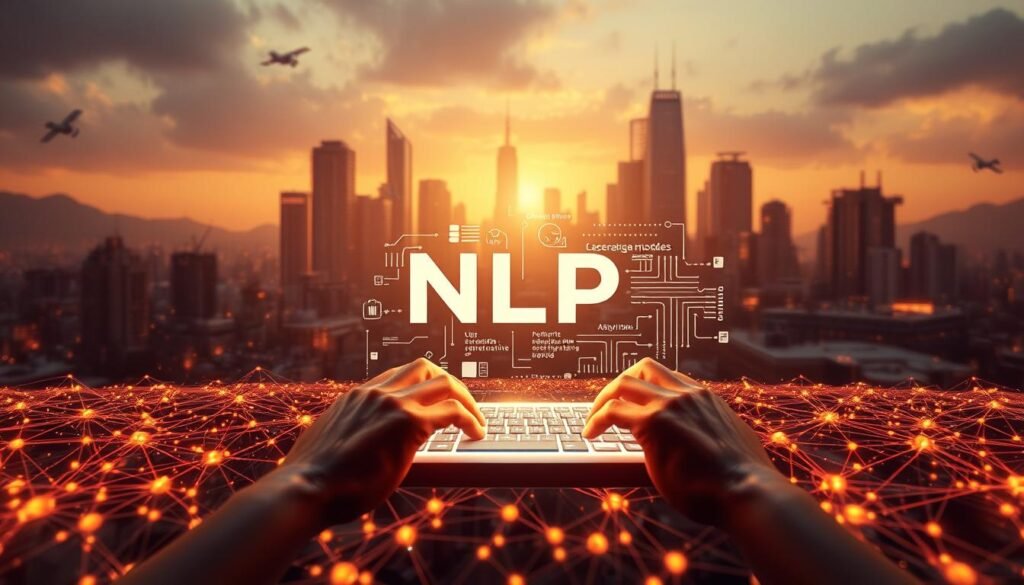ChatGPT-5 and Generative AI in Productivity, Education, and Healthcare
Did you know the global AI market is expected to hit $190.61 billion by 2025? This growth shows how big a deal ChatGPT-5 and generative AI are. They’re changing the game in many areas.
ChatGPT-5 is making a big splash in boosting productivity and changing education. It’s also making healthcare better. These technologies are not just making things faster. They’re solving big problems and thinking about the right things to do.
They help with simple tasks and make learning more personal. They also help doctors make better choices. This is changing how we work, learn, and get medical care.
Key Takeaways
- ChatGPT-5 is key to making things more efficient, helping with simple tasks and making workers better.
- Generative AI is leading a big change in education, making learning more personal and using AI for tutoring.
- AI in healthcare is making patients’ lives better by making things run smoother and helping doctors more.
- But, using AI comes with its own set of problems, like bias, keeping data safe, and following rules.
- The fast growth of AI, like ChatGPT-5, means a future where everything works better and is more tailored to us.
The Evolution of ChatGPT to ChatGPT-5
Exploring the ChatGPT evolution shows us how far AI has come. From the first versions to ChatGPT-5, we’ve seen big steps forward. These steps are thanks to ongoing improvements and major breakthroughs.
Milestones in ChatGPT Development
ChatGPT has changed a lot over time. Some key moments include:
- Getting better at understanding natural language
- Starting to support many languages
- Improving how it responds to the context
These moments show how fast ChatGPT has evolved. They also show the constant growth in AI technology.
Key Features of ChatGPT-5
ChatGPT-5 has new features that make it stand out:
- It’s more aware of the context
- It’s less biased
- It gives more accurate and relevant answers
These features make ChatGPT-5 a strong tool. It’s powered by the latest in AI technology.
Technological Advancements
The making of ChatGPT-5 uses the latest in AI tech. This includes:
- Using deep learning
- Training on a wider range of texts from around the world
- Improving how fast it works and how it interacts in real-time
How Generative AI Enhances Productivity

Generative AI is changing how we work. It uses advanced automation and real-time support to help us. This lets us do more important work instead of boring tasks.
Automation of Routine Tasks
Generative AI is great at automating simple tasks. It handles things like data entry and scheduling. This frees up employees to do more important work.
Places like retail, finance, and healthcare are seeing big improvements. This is because AI is making work more efficient.
Real-Time Decision Support
Generative AI helps companies make quick, smart choices. For example, in finance, AI analyzes markets and gives instant trading advice. This makes decisions faster and more accurate.
Improving Employee Efficiency
Generative AI does more than just automate tasks. It also helps employees work better. By using AI in daily tasks, employees can focus on what matters.
This makes work smoother and boosts productivity. It helps companies stay ahead in the market.
Generative AI in Education
AI in education is changing the game by making learning better and more personal. It brings new ways to teach that fit each student’s needs. This can lead to better grades, a more engaging learning experience, and help for both students and teachers.
Personalized Learning
AI makes learning personal by tailoring lessons to each student. Teachers use AI to create content that fits each student’s learning style and pace. This approach helps students understand better and learn more effectively.
AI looks at student data to find out what they’re good at and what they need to work on. This way, lessons can be made just for them, helping them grow in their own way.
AI Tutors and Assistants
AI tutors and virtual assistants are big steps forward in education. They’re always there to help, answering questions and providing extra learning resources. These tools make sure students get the help they need, whenever they need it.
They help fill in knowledge gaps and keep learning going. This makes learning a continuous journey, not just a one-time event.
Challenges in Integrating AI in Education
While AI in education is exciting, there are challenges to overcome. Making sure everyone has access to AI tools is key, as unequal access can widen the gap in education. AI tutors are helpful, but we can’t forget the importance of human interaction in learning.
There are also big issues with data privacy and security. We must protect student information from breaches and misuse.
| Challenges | Details |
|---|---|
| Equitable Access | Ensuring all students have access to AI tools, regardless of socio-economic status. |
| Human Touch | Balancing AI assistance with human interaction to preserve the personal aspect of learning. |
| Data Privacy | Protecting sensitive student data from breaches and misuse. |
| Ethical Considerations | Addressing the moral implications of AI use in education. |
ChatGPT-5 and Generative AI in Healthcare

Generative AI in healthcare is changing the game. It’s making patient care better and making things run smoother. ChatGPT-5 is at the forefront, helping with tasks, making decisions, and improving health outcomes.
Streamlining Administrative Tasks
AI is a big help with the paperwork. An AI assistant, like ChatGPT-5, can schedule appointments, keep records, and handle bills. This lets doctors and nurses spend more time with patients.
The AI can handle lots of data fast and right. This means tasks get done quicker and with fewer mistakes.
Supporting Clinical Decisions
ChatGPT-5 helps doctors make better choices. It looks at patient data and suggests what might be wrong and how to fix it. This makes care more personal and cuts down on mistakes.
Improving Patient Outcomes
The main goal is to make patients healthier. With ChatGPT-5, doctors can tailor treatments and keep a close eye on how patients are doing. This leads to better health and happier patients.
| Impact Area | Benefit of AI |
|---|---|
| Administrative Efficiency | Reduced workload and increased accuracy |
| Clinical Decision Support | Enhanced decision-making and reduced errors |
| Patient Outcomes | More personalized and effective treatments |
Case Studies: AI in Healthcare Research
AI has made big strides in healthcare research, like in drug discovery and personalized medicine. It’s changing how we find and use treatments. This shows AI’s power to make healthcare better by making treatments faster and more effective.
Drug Discovery
AI is changing how we find new drugs. It uses big data to guess how well new drugs will work. This cuts down the time and money it takes to make a new drug.
For example, AI has helped find new treatments for Alzheimer’s and cancer. This means researchers can focus on the best options. It speeds up finding new treatments and makes them more likely to work.
The Role in Personalized Medicine
In personalized medicine, AI uses data just for you to make treatments better. It looks at your genes, lifestyle, and health history. Then, it suggests treatments that might work best for you.
This could lead to better care for chronic diseases and cancer. It means treatments could be more precise and effective for each person.
Enhancing Medical Research
AI does more than just help find new drugs and treatments. It’s also key in medical research. It can look through lots of data to find patterns and connections that humans might miss.
This leads to stronger research that can solve big medical problems. But, we need to make sure the data is good and AI is fair to trust its results.
| AI Application | Benefits | Challenges |
|---|---|---|
| AI in Drug Discovery | Speeds up identification of drugs | Data accuracy, validation of predictions |
| Personalized Medicine | Tailors treatments to individual needs | Privacy concerns, high-quality data requirements |
| Enhancing Medical Research | Identifies new patterns and correlations | Handling biased data, ensuring data quality |
Real-World Applications in Productivity
In today’s fast-changing business world, using AI is key to boosting productivity. Generative AI, when used across different areas, has shown big improvements in many fields.
Customer Service Optimization
AI in customer service is a game-changer. It quickly answers common questions, cutting down wait times and making customers happier. For example, AI chatbots work around the clock, taking care of simple issues and passing on tough ones to people.
Workforce Augmentation
Generative AI is vital for workforce augmentation. It automates boring tasks, freeing up staff to do more creative work. It also helps in training, giving personalized lessons that help people learn new skills faster.
Operational Efficiency
AI brings big gains in operational efficiency. It uses predictive analytics to manage resources better, improve supply chains, and cut costs. By looking at past data, AI predicts demand changes, keeping inventory and production schedules just right.
AI’s role in customer service, workforce growth, and efficiency shows its huge impact on productivity in many areas.
AI-Driven Educational Tools

In today’s fast-changing world, AI is changing how we teach and learn. These tools bring new ways to learn, making it more interactive and tailored to each student’s needs.
Interactive Learning Platforms
AI-powered learning platforms are changing how we interact with school materials. They adjust to each student’s learning style and speed. This makes learning more fun and helps students remember better.
Assessment and Feedback
AI tools also give detailed feedback and assessments. They help teachers see how students are doing and where they need help. This feedback is quick and helps students learn better.
| Feature | Benefits |
|---|---|
| Adaptive Learning | Personalized pace and style for each student |
| Interactive Content | Enhanced engagement and retention |
| Detailed Feedback | Timely and actionable insights for educators |
Using AI tools in schools can make learning better. It helps students reach their goals and teachers give more personal help. This is a big step forward in education.
Ethical Considerations in AI Deployment
The use of AI raises big ethical questions. We need to make sure AI is used right in all areas. This includes looking at bias, privacy, and following rules.
Bias and Fairness
AI systems can have biases. These biases come from the data and algorithms used. We must find ways to spot and fix these biases for fairness.
It’s important to check and update AI models often. This makes them fairer and more reliable.
Data Privacy and Security
Keeping user data safe is key in AI ethics. AI handles a lot of personal info, so we need strong privacy steps. This means using things like encryption and making data anonymous.
It’s also important to follow rules like GDPR and CCPA. This helps keep users’ trust.
Regulatory Compliance
The rules for using AI are changing fast. Governments are making laws to help use AI right. Following these laws is not just about avoiding trouble. It’s about using AI in a good way.
We need clear rules and to keep checking on AI use. This helps us follow the law and use AI well.
“It is important to think about the ethics of AI to build trust and fairness.”—Sundar Pichai, CEO of Alphabet Inc.
| Aspect | Key Considerations | Actions |
|---|---|---|
| Bias and Fairness | Mitigating biases in data and algorithms | Regular audits, diverse datasets |
| Data Privacy and Security | Protecting user information | Encryption, compliance with regulations |
| Regulatory Compliance | Aligning with legal frameworks | Transparent governance, continuous monitoring |
Challenges and Limitations of Generative AI

Generative AI is a big step forward, but it faces many challenges and limits. We need to tackle these to make sure the tech is both useful and fair.
Handling Inaccurate Information
One big problem is dealing with wrong information. Generative AI can sometimes make up or get things wrong. This is very serious in areas like healthcare and education.
To fix this, we must have strong checks and keep improving the tech. This will help make sure the information is right.
Managing AI Bias
Another big issue is AI bias. Bias can come from the data used to train the AI. This can lead to unfair or biased results.
This problem not only makes AI less reliable but also raises big ethical questions. It’s key that developers use a wide range of data and test the AI well to find and fix biases.
Scalability Issues
Scalability is a big problem for AI, too. As AI grows and is used in more places, it gets harder to keep it working well. This is because it needs to handle more tasks and data.
Using things like modular designs and learning that adapts can help. These methods make it easier to use AI in different situations and keep it running smoothly.
Impacts of ChatGPT-5 on Workforce Dynamics
The rise of ChatGPT-5 has changed how we work, making it key for companies to adjust. This part talks about how ChatGPT-5 is changing jobs, improving skills, and affecting how workers feel at work.
Job Transformation
ChatGPT-5 is changing many jobs, leading to big changes in how we work. Tasks that are repetitive are now automated, letting workers do more important work. This change encourages innovation and creativity, creating jobs that need advanced thinking.
While some jobs might disappear, new ones will come, boosting the economy and job happiness.
Skill Development
With more AI at work, learning AI skills is key. Workers need to know how to work with AI. Training in AI, data analysis, and machine learning is vital for the future.
Companies that train their staff well will see big gains in productivity and worker happiness.
Employee Acceptance
How workers feel about AI, like ChatGPT-5, varies a lot. Some see the benefits of AI, like better efficiency. But others worry AI might take their jobs.
Creating a culture of openness and learning can help. Talking openly and showing how AI helps, not replaces, can make workers more accepting.
- Transparency in AI Use
- Continuous Learning Programs
- Open Communication Channels
For ChatGPT-5 to work well, we need to balance job changes, skill learning, and worker acceptance. Companies that get this right will have an edge in the AI world.
Advancing Natural Language Processing
Natural language processing (NLP) has seen big leaps forward. It’s now better at understanding context and working with other technologies. Training methods for language models have also improved a lot. These changes help AI solutions work better and more accurately.
Improving Context Understanding
AI can now understand context much better. It looks at text in a bigger picture, giving more precise answers. This makes talking to AI feel more natural, improving our experience with it.
Seamless Integration with Other Technologies
AI is now easier to integrate with other tech. Seamless integration means NLP tools work well with IoT, big data, and cloud computing. This makes AI more useful in many fields, making things run smoother.
Language Model Training Improvements
Training for language models has gotten a lot better. New algorithms and big datasets help models learn to write and understand text better. This means AI can give answers that are more on point and relevant.
Here is a summary table showing key advancements in natural language processing:
| Advancement | Description | Impact |
|---|---|---|
| Improved Context Understanding | Enhanced ability to grasp textual data within broader contexts. | More accurate and human-like AI responses. |
| Seamless AI Integration | Increased interoperability with other technologies like IoT and cloud computing. | Boosted operational efficiency across industries. |
| Language Model Training | Advanced algorithms and expansive datasets for training models. | More relevant and contextually appropriate AI outputs. |
The Future of Conversational AI
The future of AI, including conversational AI, is looking bright. The field is changing fast, thanks to new ideas and research. These changes will make many areas better, making things more efficient and solving old problems.
Trends in AI Development
One big trend is making AI talk more like us. It can now understand and create text that sounds human. This makes talking to AI smoother and more natural. Also, using voice and visual data makes interactions even better.
Predictions for Generative AI
We think generative AI will play a big part in work life soon. It will help with tasks like making content and understanding customers. This will help companies work smarter and serve customers better.
Long-Term Implications for Various Sectors
Generative AI will change many fields. In healthcare, it could make diagnosing diseases more accurate. In schools, it will help students learn in a way that fits them best. And in work, it will make tasks easier, freeing up time for more important things.
As AI keeps getting better, it will change how we do business and live our lives. It will open up new ways to innovate and grow.





